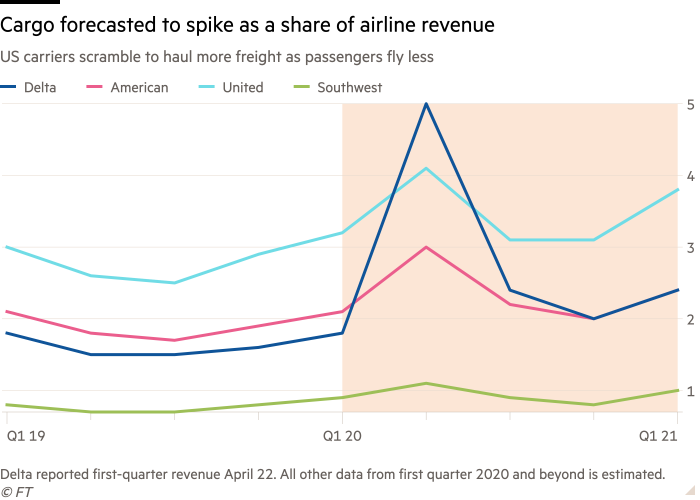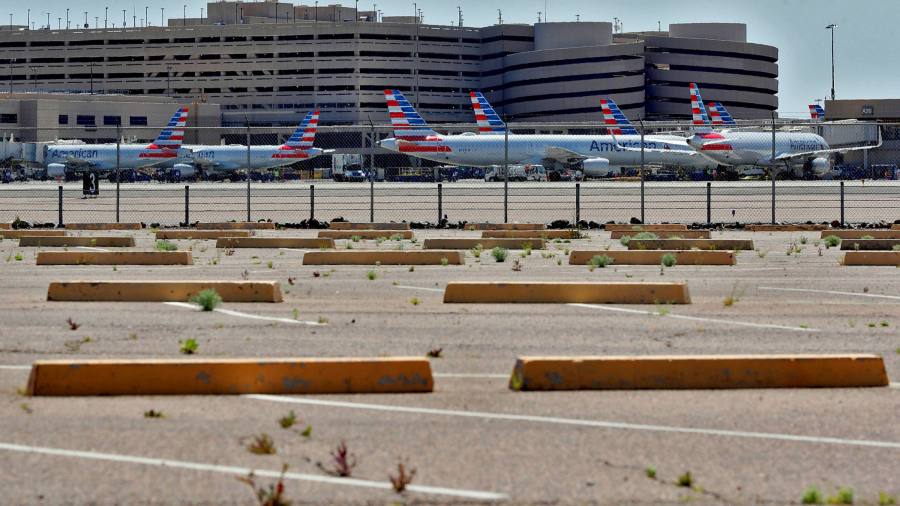The American Airlines’ 777-300 jet carried more than 115,000 pounds of corn and soyabean seeds, and no passengers.
The seeds, loaded in Buenos Aires, were bound first for Miami, and then on to farms in the American Midwest for planting. American began cargo-only flights last month, and the one on April 16 would have yielded far more revenue than last year’s seed shipment, which shared a flight with passengers. Industry sources estimate that a 2019 shipping bill of $100,000 or less would have ballooned this spring to $240,000.
As travellers stay home because of the coronavirus pandemic and revenue tumbles, American and other US carriers are pivoting to freight. Demand for goods has decreased more slowly than travel demand, and some items, such as personal protective equipment, are newly critical. In normal times passenger planes move about 55 per cent of the world’s cargo, but with so few planes flying, space is precious, and rates are rocketing.

Air Canada, Lufthansa and Icelandair all have reconfigured a few planes to carry cargo in the main cabin, and on Thursday the Federal Aviation Administration cleared Delta Air Lines as the first US carrier to transport goods in the cabin. With airlines taking government funds, issuing fresh shares and drawing down billions in loans, every dollar helps.
“Cargo remains somewhat robust and a good opportunity for them to generate some revenue when the core passenger side has been suffering,” said Citi analyst Stephen Trent. “If you have to run those flights anyway, best to run them with the belly full.”
Last month American flew its first cargo-only flight in 36 years. The Fort Worth company generated $216m from cargo in the fourth quarter of 2019, or 1.9 per cent of total sales.
As passenger revenue falls, analysts polled by FactSet expect that percentage to rise to 2.1 per cent in the first quarter of 2020 and 3 per cent in the second. Last week American flew 46 cargo-only routes; it plans to “almost double” that number by May 7.
United is operating 180 cargo-only flights per week. Analysts expect cargo to reach 4.1 per cent of United’s sales in the second quarter, up from 2.9 per cent in December 2019. They expect Southwest Airlines and Delta Air Lines also to peak for cargo in June, with Delta hitting 5 per cent —$652m from cargo on $2.3bn in sales.
“We’ve instituted charters going over to China as we’re bringing medical supplies, (personal protective equipment) back to the workers on the front line of this crisis,” said Delta Air Lines chief executive Ed Bastian.
“We’re taking some of the main deck seats off a few of our international planes to facilitate taking greater lift in the short term, and we’ll continue to use those resources where it makes sense, certainly for some time to come.”
Commercial rates for air cargo have soared. Goods moving on certain routes from China to the US now range from $13 to $19 per kilo, said Brian Bourke, chief growth officer at Illinois freight forwarder Seko Logistics. A year ago the cost was between $3 and $6. American also started charging a fee to shippers for last-minute cancellations.
Mr Bourke added that it was a struggle to secure space. He said, “If you don’t take it, someone else will, five minutes later . . . The airlines are in a position to benefit. It’s not going to replace the passenger revenue at all, but it helps.”
But UPS and FedEx, which operate air freight businesses, need not fear serious competition from airlines, said Citi analyst Chris Wetherbee. Passenger jets cannot transport cargo as efficiently as dedicated planes, and airlines will hesitate to retrofit significant portions of their fleet.
Freight handlers can unload a 747 in 45 minutes, driving forklifts straight into the belly of the plane. Passenger jets, particularly ones carrying cargo in the cabin, take longer.
Mr Bourke said an increased number of converted planes is contributing to offloading congestion at airports in New York, Los Angeles and Chicago.
“There’s more air freight moving through these airports than typical,” he said. “We only see it getting worse.”


